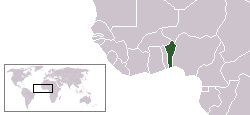 Benin, Africa Benin, Africa
République du Bénin
Republic of Benin
Quick Facts About the Country
Capital: Porto-Novo is the official capital; Cotonou is the seat of government
Government - Republic under multiparty democratic rule
Currency - Communaute Financiere Africaine franc (XOF)
Area total: 112,620 km2
water: 2,000 km2
land: 110,620 km2
Population - 6,787,625 (July 2002 est.)
Language - French (official), Fon and Yoruba (most common vernaculars in south), tribal languages (at least six major ones in north)
Religion - Indigenous beliefs 50%, Christian 30%, Muslim 20% Background
Benin, officially the Republic of Benin, is a country in Western Africa, formerly known as Dahomey or Dahomania. It has a small coast line with the Bight of Benin in the south, borders Togo in the west, Nigeria in the east, and Burkina Faso and Niger in the north. (It has no particular connection to Benin City or the Kingdom of Benin).
(Wikimedia Foundation, Inc)
Weather and Climate
Benin's climate ranges in type from equatorial in the south to an increasingly arid tropical wet-and-dry climate in the north. The south receives about 1,300 mm (about 51 in) of rainfall a year, mostly during March to July and October to November; the average monthly temperature ranges from 20° to 34°C (68° to 93°F). Temperatures also are high in the north, and the annual rainfall of about 890 mm (about 35 in) occurs mainly from May to September.
(Microsoft® Encarta® Reference Library 2003)
Major Travel and Tourism Info (Travel Guide)
Understand
The current government is a republic under multiparty democratic rule. Benin dropped Marxism-Leninism December 1989 and adopted democratic reforms in February 1990. A transition to multiparty system was completed 4 April 1991.
Traveling by Plane
There are many international flights arriving at the main airport in Cotonou. From here you can connect to Paris, Amsterdam, Moscow, and a variety of cities in West Africa.
By train
Travel into Benin via train is not possible. However, there is a train route that goes halfway up the country, from Cotonou to Parakou. While it takes longer than a bush taxi, it's a much more relaxing way of traveling. First class tickets are only slight more that second class ones and are worth the extra expendature. The train leaves Cotonou three times a week (tuesday, thursday, and saturday) at 8 am precisely and returns the next day, leaving at 8 am from the Parakou train station.
Language and Communication
The official language is French - the language of the former colonial power. Native African languages such as Fon and Yoruba in the south, as well as Bariba and Dendi in the north, are also widely spoken, as are over 50 other African languages and dialects.
(Wikimedia Foundation, Inc) History in Brief: Summary
Present day Benin was the site of Dahomey, a prominent West African kingdom that rose in the 15th century. The territory became a French Colony in 1872 and achieved independence on 1 August 1960, as the Republic of Benin. A succession of military governments ended in 1972 with the rise to power of Mathieu KEREKOU and the establishment of a government based on Marxist-Leninist principles. A move to representative government began in 1989. Two years later, free elections ushered in former Prime Minister Nicephore SOGLO as president, marking the first successful transfer of power in Africa from a dictatorship to a democracy. KEREKOU was returned to power by elections held in 1996 and 2001, though some irregularities were alleged. .
(The World Factbook 2006)
References
Bureau of Consular Affairs, U.S. Department of State
Microsoft® Encarta® Reference Library 2003
The World Factbook 2006
Wikimedia Foundation, Inc
| 
